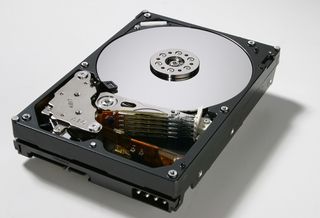Magnetic "wobbles" cause disk failure
New research could lead to more reliable hard disks

Scientists have discovered one of the major causes of hard disk failure.
According to researchers working at the University of California and Hitachi Global Storage Technologies, understanding certain types of disk drive failures, called magnetic avalanches, could help disk drive manufacturers produce more reliable storage.
Magnetic avalanches occur when a magnetic head hovers over a patch of disk drive causing the polarity of that part of the drive to change its alignment or spin. The patch's polarity in many magnetic materials changes in a haphazard series of large and small jumps that physicists liken to an avalanche - though the scientist's research showed it often behaves more like an explosion or runaway fire. These avalanches can cause sections of hard drive to lose data.
Research was carried by Joshua Deutsch, professor of physics at the University of California, Santa Cruz, and Andreas Berger, who did the research while at Hitachi Global Storage Technologies.
Deutsch said that the research paper, published in 13 July edition of Physical Review Letters, that the findings advanced knowledge of magnetic spin in drives.
"The big advance in this paper is that in previous models of avalanches, the spin just flips from up to down as soon as they apply a magnetic field, and they're done. But that's not the way spin behaves in the real world," Deutsch said.
The scientists said that previous models overlooked an effect called "spin precession", which each magnetic field exerts on its neighbours. The scientists likened each individual bit of information on a platter to a "tiny pincushion bristling with individual magnetic fields."
Get the ITPro. daily newsletter
Receive our latest news, industry updates, featured resources and more. Sign up today to receive our FREE report on AI cyber crime & security - newly updated for 2024.
As the head of the drive nears, each pin wobbles in a widening circle - pointing neither up or down but somewhere in between - before it settles on its new polarity. They called that wobbling "precession" and said it resembled the way a spinning top draws out circles as it rotates.
"It takes around a few nanoseconds for a precession to die down," said Deutsch. "That's not that fast compared to computers today. It's not as fast as the timescale you get for a transistor to switch." During that brief time, each magnetic field contributes forces that affect the precession of neighbouring fields. Each of these spins
Combining all those wobbles adds up to a lot of energy that changes the polarity of neighbouring bits and spreads across the surface, causing sections of disk drive to be wiped out.
The researchers suggested that the reason these avalanches die out is that the magnetic material can dampen the wobbles. They said that materials that good damping abilities would make candidates for use in hard drives.
"Obviously, disk drive makers have already learned by an enormous amount of ingenuity and trial and error what materials make good disks," Deutsch said. "But now we understand a lot better one of the reasons why - because the materials are good at damping, and we can quantify how damping will stop runaway avalanches. We still can't calculate their damping, but at least we can measure it."
Rene Millman is a freelance writer and broadcaster who covers cybersecurity, AI, IoT, and the cloud. He also works as a contributing analyst at GigaOm and has previously worked as an analyst for Gartner covering the infrastructure market. He has made numerous television appearances to give his views and expertise on technology trends and companies that affect and shape our lives. You can follow Rene Millman on Twitter.





